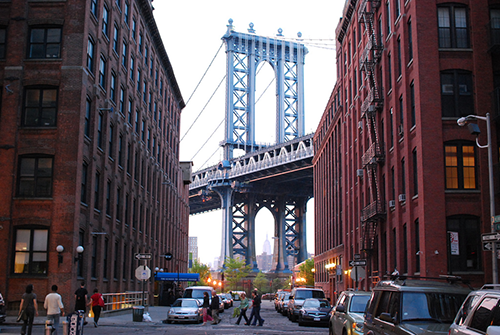Oct 14 2015 From DUMBO to Boston: reflections on urban innovation
 By Ariella Cohen, Editor-in-Chief, Next City
By Ariella Cohen, Editor-in-Chief, Next City
This post appears as the foreword in our new report The Development of Boston’s Innovation District: A Case Study of Cross-Sector Collaboration and Public Entrepreneurship.
My first post-college office was a converted loft in the DUMBO section of Brooklyn. The year was 2004; the Internet was only then beginning to transform the way we live and work, yet big changes were afoot, and my boss’s landlord, David Walentas, knew it.
Twenty-five years earlier the real estate developer had gambled $12 million on 2 million square feet of industrial property underneath the Manhattan Bridge. It was a lot of money for a noisy warren of half-empty warehouses and fetid cobblestoned alleys, but Walentas hunkered down for the long haul on the intuition that the neighborhood’s resident industries were soon to change. By the time I arrived on the scene with a job at an independent Brooklyn newspaper and a scrappy commuter bike, the warehouses were teeming with young computer programmers and MacBook-toting graphic designers.
I encountered my first software entrepreneur on the creaky freight elevator I rode up to my office every day and drank my first locally brewed kombucha in the overpriced grocery store on the building’s first floor. Eventually, both the software guy and the local kombucha made their way into my newspaper stories.
To innovate is to disrupt the established order and introduce something new. … The ideal end result is the increased creative production associated with the kind of spontaneous cross-sector interaction I experienced in DUMBO, not to mention new tax revenue and jobs.
Walentas didn’t call DUMBO an innovation district. He didn’t have to. The creative energy was palpable in the neighborhood’s narrow streets – and Walentas had subsidized the rents of enough startups, artists, and media types that no one was going anywhere else anytime soon, anyhow.
Eleven years later, Walentas has been made a millionaire many times over, and DUMBO is one of the city’s wealthiest (and most Instagram-ready) neighborhoods, a mix of glassy multi-million-dollar condo towers, hip offices, and posh commerce catering to residents with a median household income of $181,684. (By comparison, the median income for the city as a whole is $50,711.)
I still have a few artist and journalist friends who work in the neighborhood thanks to the discounted office space that Walentas continues to provide in hope of maintaining the neighborhood’s buzz. Yet more and more, the neighborhood feels like a study in luxury urbanism. It’s lovely to visit but not a replicable or even desirable model for most cities.
To innovate is to disrupt the established order and introduce something new. Brookings Institution researchers Bruce Katz and Julia Wagner describe innovation districts as “physically compact, transitaccessible” mixed-use areas where “leading-edge anchor institutions and companies cluster and connect with startups, business incubators, and accelerators.” The ideal end result is the increased creative production associated with the kind of spontaneous cross-sector interaction I experienced in DUMBO, not to mention new tax revenue and jobs.
These districts represent a mash-up of the development strategy that made a gritty neighborhood under a loud bridge desirable to entrepreneurs and wealthy condo-buyers, and an emerging model predicated on collaboration and government involvement. Instead of Walentas’ one-man, market-driven show, they are the product of long-term planning and shared investment on the part of taxpayers, anchor institutions, and private-sector partners.
In cities such as Pittsburgh, Detroit, Buffalo, St. Louis, and Boston, the model is being adapted to meet local needs with programs intended to foster a more inclusive ecosystem that will create economic opportunities not only for those already connected to the tech sector but also those who need a way in.
As with any public-private partnership, these collaborations carry risk but also the potential for new public benefit. Where in the past a developer like Walentas may have been held accountable for hiring locally or building a minimal number of affordable units mixed in with the luxury apartments – 58 of them in the case of DUMBO – this new model presents an opportunity to plan strategically with public needs in mind and, ultimately, create a place that reflects the interests of a diverse urban populace. In cities such as Pittsburgh, Detroit, Buffalo, St. Louis, and Boston, the model is being adapted to meet local needs with programs intended to foster a more inclusive ecosystem that will create economic opportunities not only for those already connected to the tech sector but also those who need a way in. In other words, these cities are seeking to do something truly innovative: disrupt a pattern of inequality.
With this report, The Intersector Project offers an insightful exploration of collaborations across the business, government, and non-profit sectors in the context of the Boston Innovation District, one of the earlier examples of this emerging model for 21st century economic development. Since 2010, more than 200 startups have set up shop in the area, creating hundreds of new jobs and contributing to the city’s reputation as a hotbed for tech-driven entrepreneurship. Yet as the District continues to grow, it faces new challenges of accessibility, affordability, and identity – challenges that can only be addressed through more collaboration and yes, innovation. Indeed, we are not in DUMBO anymore.
Ariella Cohen is an award-winning journalist with 11 years of experience reporting on urban change, politics, and policy. Prior to joining Next City – a non-profit organization with a mission to inspire social, economic, and environmental change in cities through journalism and events around the world – she co-founded New Orleans’ first online investigative news outlet, The Lens, and worked as a staff reporter for the Brooklyn Paper in New York. She has reported on disaster recovery, urban development, and city politics in Port-au-Prince, Jerusalem, and in cities across the United States. Follow her @ariellacohen on Twitter.
